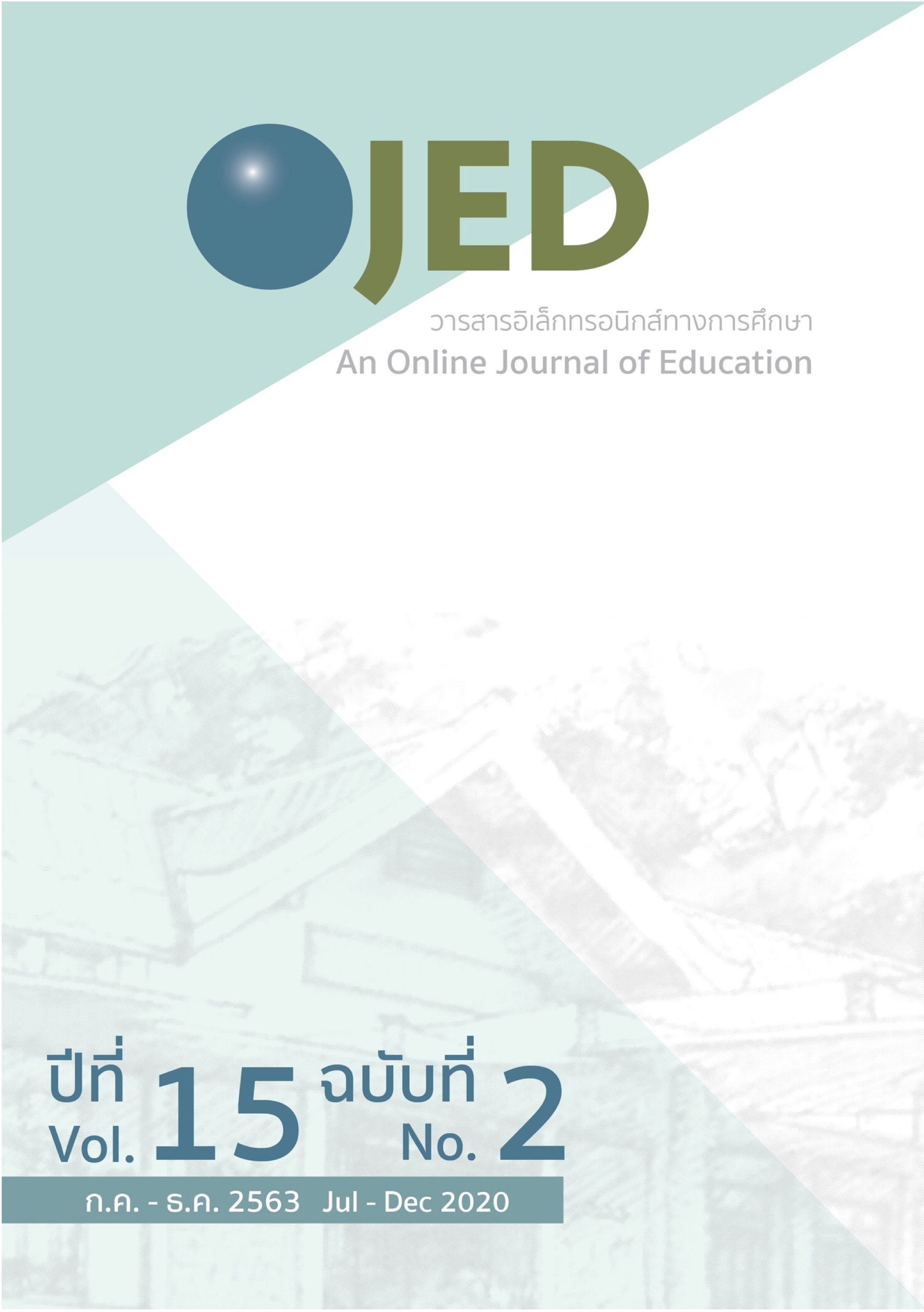An Analysis of Digital Competence Factors for Teachers
DOI:
https://doi.org/10.14456/ojed.2020.37Keywords:
digital competence, student teacherAbstract
The objectives of this research were 1) to analyze the components of digital competence for teachers, and 2) to develop digital competence questionnaires. This study employed an exploratory sequential mixed-methods research design. The study was divided into two phases. Phase 1 analyzed the components of digital competence for teachers by collecting data from 10 educational technology expert via interviews. The data were analyzed by content analysis. Phase 2 comprised a quantitative study, collecting data from 55 student teachers at Chulalongkorn University in Bangkok, Thailand. The research instrument was the digital competence questionnaire. The data were analyzed using the Cronbach alpha coefficient and confirmatory factor analysis.
Research results are as follows: 1. Digital competence consists of 5 factors. These are basic knowledge of digital media and technology, digital media and technology skills, choosing digital media and technology, creating digital media and technology, and media ethics. 2. In analyzing the digital competence questionnaires: 2.1 The Cronbach alpha coefficient was .944, and 2.2 The structural model of digital competence fit well with the empirical data, at a significance level of .05 (X2(3, N=55) =1.843, p > .05).
References
ศิริชัย กาญจนวาสี. (2548). ทฤษฎีการประเมิน. จุฬาลงกรณ์มหาวิทยาลัย.
สันติพจน์ กลับดี. (2558, 5 มิถุนายน). ทักษะขั้นพื้นฐานเพื่อการเรียนรู้ด้วยเทคโนโลยีสารสนเทศและการสื่อสาร. http://www.aseanthai.net/sub_convert.php?nid=3314
สำนักงานเลขาธิการคุรุสภา. (2556). ข้อบังคับคุรุสภาว่าด้วยมาตรฐานวิชาชีพ พ.ศ. 2556. กระทรวงศึกษาธิการ.
สุกานดา จงเสริมตระกูล. (2556). ระบบการเรียนแบบกลุ่มสืบสอบบนแหล่งทรัพยากรด้านการศึกษาแบบเปิดเพื่อส่งเสริมการรู้สารสนเทศดิจิทัลและการรับรู้ทางจริยธรรมทางสารสนเทศของนิสิตนักศึกษาครุศาสตร์ ศึกษาศาสตร์ [วิทยานิพนธ์ปริญญาครุศาสตรมหาบัณฑิต]. Chulalongkorn University Intellectual Repository (CUIR). http://cuir.car.chula.ac.th/handle/123456789/43162
อดิศักดิ์ จำปาทอง. (2556, 21 มีนาคม). Digital sphere โลกยุคใหม่ของสื่อดิจิทัล. Knowledge Management Nation University. http://blog.nation.ac.th/?p=2493
Calvani, A., Cartelli, A., Fini, A., & Ranieri, M. (2009). Models and instruments for assessing digital competence at school. Journal of E-learning and Knowledge Society, 4(3), 183-193.
Europe commission. (2014). A common European digital competence framework for citizens. https://openeducationeuropa.eu/sites/default/files/DIGCOMP%20brochure%202014%20.pdf
Hair, J. F., Anderson, R. E., Babin, B. J., & Black, W. C. (2010). Multivariate data analysis: A global perspective. Pearson.
Hatlevik, O. E., Guðmundsdóttir, G. B., & Loi, M. (2015a). Digital diversity among upper secondary students: A multilevel analysis of the relationship between cultural capital, self-efficacy, strategic use of information and digital competence. Computers & Education, 81, 345-353. https://doi.org/10.1016/j.compedu.2014.10.019
Hatlevik, O. E., Guðmundsdóttir, G. B., & Loi, M. (2015b). Examining factors predicting students’ digital competence. Journal of Information Technology Education, 14, 123-137. https://doi.org/10.28945/2126
Hatlevik, O. E., Ottestad, G., & Throndsen, I. (2015c). Predictors of digital competence in 7th grade: A multilevel analysis. Journal of Computer Assisted Learning, 31(3), 220-231. https://doi.org/10.1111/jcal.12065
Higgins, S., Xiao, Z., & Katsipataki, M. (2012). The impact of digital technology on learning: A summary for the education endowment foundation. Education Endowment Foundation and Durham University.
Krumsvik, R. J. (2008). Situated learning and teachers’ digital competence. Education and Information Technologies, 13(4), 279-290.
Krumsvik, R. J., & Jones, L. Ö. (2013). Teachers’ digital competence in upper secondary school: (Work in Progress). International Conference on Information Communication Technologies in Education, 171-183.
Li, Y., & Ranieri, M. (2010). Are digital natives really digitally competent? A study on Chinese teenagers. British Journal of Educational Technology, 41(6), 1029-1042. https://doi.org/10.1111/j.1467-8535.2009.01053.x
Maderick, J. A., Zhang, S., Hartley, K., & Marchand, G. (2016). Preservice teachers and self-assessing digital competence. Journal of Educational Computing Research. 54(3), 326-351. https://doi.org/10.1177/0735633115620432
Mareco, D. (2017, 28 July). 10 Reasons today’s student need technology in the classroom. https://www.securedgenetworks.com/blog/10-reasons-today-s-students-need-technology-in-the-classroom
Meyers, E. M., Erickson, I., & Small, R. V. (2013). Digital literacy and informal learning environments: An introduction. Learning, Media and Technology, 38(4), 355-367.
Svensson, M., & Baelo, R. (2015). Teacher students’ perceptions of their digital competence. Procedia-Social and Behavioral Sciences, 180, 1527-1534. https://doi.org/10.1016/j. sbspro.2015.02.302
Downloads
Published
How to Cite
Issue
Section
License

This work is licensed under a Creative Commons Attribution-NonCommercial-NoDerivatives 4.0 International License.




